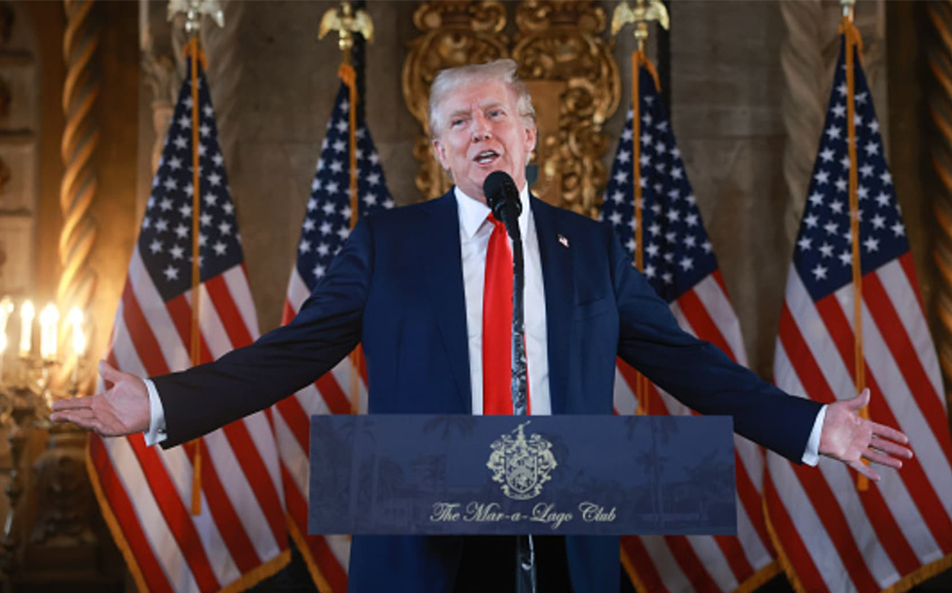
The United Indian

On November 6, 2024, Donald J. Trump made history once again by winning the U.S. presidential election, returning to the Oval Office for an unprecedented second non-consecutive term. In the landscape of American politics, few figures have generated as much discussion, debate, and division as Donald Trump. From a real estate mogul to reality TV star to the 45th & Now 47th President of the United States, Trump's journey represents one of the most remarkable political transformations in modern American history. This achievement marks Trump as only the second president in American history to secure such a comeback, following Grover Cleveland in the late 19th century. This momentous occasion prompts a reflection on Trump’s political journey—one marked by resilience, controversies, and a steadfast commitment to his vision for America. Republican candidate Donald Trump had won over 30 states, including Pennsylvania, Georgia, North Carolina, Texas, Florida, Indiana, Kentucky, and more, while Democrat Kamala Harris had only won 20 states.
The Beginning of an Unconventional Political Journey
Donald John Trump, born on June 14, 1946, in Queens, New York, initially rose to fame as a real estate developer and television personality. He made his mark in business with the Trump Organization, a family-owned company. In Manhattan, he transformed the landscape with signature buildings like Trump Tower, expanding his empire to include hotels, casinos, and golf resorts worldwide. His flair for self-promotion and media attention made him a household name, further amplified by his role as host of "The Apprentice" (2004-2015).
The Political Awakening
Trump's political interests weren't sudden. As early as 1987, he took out full-page newspaper ads discussing American foreign policy. He briefly sought the Reform Party's presidential nomination in 2000 and was a vocal figure during Barack Obama's presidency, particularly in promoting the "birther" movement.
In 2015, Trump surprised the world by announcing his candidacy for president as a Republican. Despite skepticism from the political establishment, his direct and controversial rhetoric quickly attracted a dedicated base of supporters. Trump’s campaign slogan, Make America Great Again (MAGA), resonated with millions who felt left behind by traditional politics and fueled his rapid rise within the Republican Party.
2016: The Road to the White House
In the 2016 Republican primaries, When Trump descended the golden escalator at Trump Tower to announce his presidential candidacy, many dismissed it as a publicity stunt. His campaign broke virtually every rule in the political playbook. Trump faced well-established politicians, including senators, governors, and longtime public servants. Yet, his unconventional approach, media savvy, and willingness to challenge political norms set him apart. He won the nomination, defeating rivals with his direct, unfiltered style and promises to “drain the swamp” of Washington elites.
Trump’s opponent in the 2016 presidential election was former Secretary of State Hillary Clinton. The election saw intense polarization, with Trump’s outspoken views on immigration, trade, and national security gaining both ardent support and fierce criticism. Trump’s victory in November 2016 defied polling predictions and cemented his position as a leader who could mobilize a large, diverse coalition of voters.
President Trump’s First Term (2017-2021)
Trump's first term in office was marked by sweeping policy changes, bold initiatives, and a focus on “America First” principles:
1. Tax Reforms and Economic Policies
In 2017, Trump passed the Tax Cuts and Jobs Act, one of the largest tax overhauls in decades, which reduced corporate tax rates from 35% to 21% and offered cuts to individual taxpayers. The goal was to stimulate business investment and economic growth, which resulted in a period of low unemployment and a strong stock market before the COVID-19 pandemic hit.
2. Border Security and Immigration
Trump’s administration took a hard stance on immigration, advocating for stricter border control and the construction of a wall along the U.S.-Mexico border. This promise, central to his campaign, led to a partial construction of the wall and increased enforcement of immigration laws, although it sparked heated national debates and legal battles.
3. Foreign Policy and International Trade
Trump pursued a foreign policy focused on reshaping alliances and enforcing trade policies he viewed as beneficial to the U.S. His administration renegotiated NAFTA into the USMCA (United States-Mexico-Canada Agreement) and imposed tariffs on China, aiming to address trade imbalances and protect American manufacturing jobs.
4. Judicial Appointments
One of Trump’s most lasting impacts was his appointment of three Supreme Court Justices: Neil Gorsuch, Brett Kavanaugh, and Amy Coney Barrett. These appointments solidified a conservative majority in the court, shaping U.S. judicial decisions for years to come.
5. Response to the COVID-19 Pandemic
In 2020, the COVID-19 pandemic presented unprecedented challenges. Trump’s administration initiated Operation Warp Speed, a program that accelerated vaccine development. However, his handling of the pandemic drew mixed reactions, with some praising his efforts to keep the economy open and others criticizing his approach to public health messaging.
The 2020 Election and Beyond
Despite his strong base, Trump’s re-election campaign in 2020 faced obstacles. Joe Biden won the election, and Trump’s post-election period saw numerous legal challenges disputing the results. Although these claims did not change the outcome, they fueled a narrative of distrust in the electoral process among Trump’s supporters.
After leaving office, Trump maintained his influence within the Republican Party. His endorsement became a powerful tool in Republican primaries, allowing him to shape the party’s direction even as a private citizen. In the years leading up to 2024, Trump continued to rally support across the country, capitalizing on his position as a voice for the “America First” movement.
2024: A Historic Comeback
Trump’s decision to run for president in 2024 sparked a wave of anticipation. His slogan, “America First, Again,” symbolized a return to his core policy objectives: economic revival, strong border security, and an assertive stance on the world stage. Trump’s 2024 campaign emphasized themes of American sovereignty, economic strength, and security, resonating with his base and attracting new supporters who desired a change from the status quo.
The 2024 election saw intense campaigning, with Trump rallying in states across the nation, drawing large crowds, and employing a digital strategy that engaged millions. His victory on November 6, 2024, marked a historic moment and a new chapter in U.S. politics.
What to Expect from Trump’s Second Term
With Trump back in office, his administration is likely to build upon the goals and priorities he established during his first term. Key areas to watch include:
1. Economic Revitalization
Trump has promised to continue his tax-cut policies and reduce regulatory hurdles, with the aim of fostering economic growth and encouraging job creation. He has expressed an interest in reshoring American manufacturing and addressing inflation, promising relief to middle-class families.
2. Immigration and Border Security
Trump’s second term may bring a renewed focus on immigration reform and stricter border control measures. He is expected to continue expanding border security infrastructure and advancing policies to curb illegal immigration.
3. Foreign Relations
Trump’s foreign policy is likely to maintain a strong focus on prioritizing U.S. interests. His approach may involve re-evaluating alliances, enforcing trade policies that favor American industries, and taking a firm stance against adversarial nations.
4. Judicial and Social Policies
Trump may further influence the judiciary by nominating additional conservative judges to federal courts, potentially shaping the legal landscape on issues such as abortion, gun rights, and healthcare.
Legacy and Future Impact
Donald Trump’s political journey is one of the most unique and impactful in modern American history. From his rise as a businessman to becoming a two-term president, Trump’s influence has reshaped the Republican Party and redefined political discourse in the United States. His return to the presidency in 2024 signifies a resurgence of the populist and nationalist ideals that he championed.
Trump’s legacy will continue to spark debate, reflecting the deeply polarized political environment of America. Supporters view him as a champion of American values and a defender of working-class citizens, while critics see his policies as divisive and controversial. Regardless of one’s views, Trump’s journey underscores his resilience and the lasting mark he has left on U.S. politics.
Conclusion
As Donald Trump embarks on his second term, his administration faces both challenges and opportunities to shape America’s future. From economic policies to international relations, Trump’s leadership will influence the direction of the nation & other major economies for years to come. Love him or hate him The world watches closely as Trump is all set to re-enter the White House, anticipating how his presidency will impact both the U.S. and global affairs.
Congratulations once again to President Donald Trump on his historic 2024 victory.
Read more in Recent Events
Jun 29, 2025
TUI Staff
Jun 27, 2025
TUI Staff
Jun 26, 2025
TUI Staff

Stay Tuned with The United Indian!
Our news blog is dedicated to sharing valuable and pertinent content for Indian citizens. Our blog news covering a wide range of categories including technology, environment, government & economy ensures that you stay informed about the topics that matter most. Follow The United Indian to never miss out on the latest trending news in India.
©The United Indian 2024













